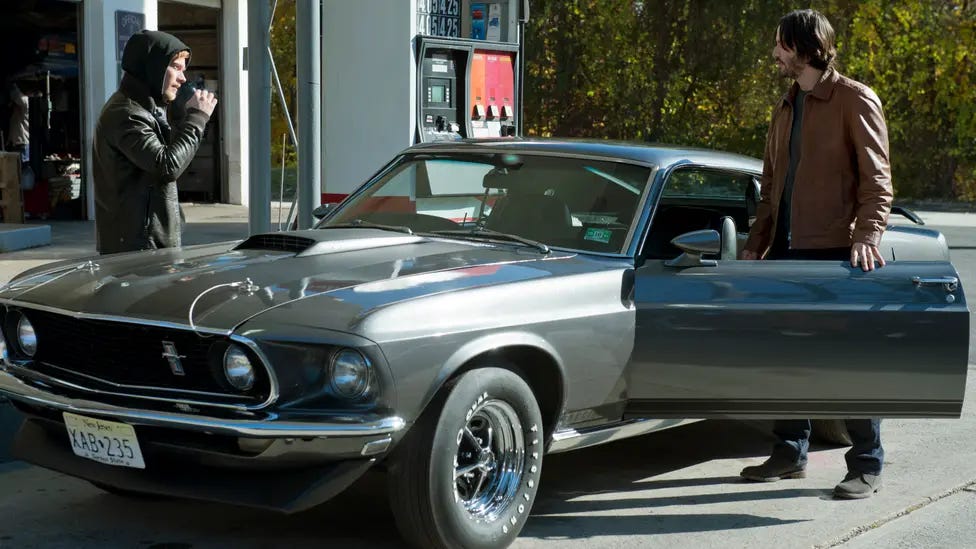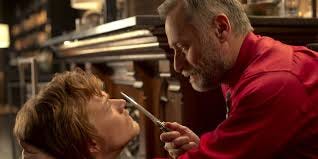The Revenge Trope: Tightening the Ties that Bind in John Wick
A detailed look at the first twenty nine minutes of John Wick (2014).
I love the revenge trope. Settling scores against those who have wronged us is part of the human condition; look at the Knives Out franchise and Freida McFadden’s The Housemaid as recent popular revenge trope examples.
But what’s so impressive about this trope that stretches back to Shakespeare’s Hamlet?
"Revenge, the attribute of gods! They stamped it with their great image on our natures." ~ Thomas Otway
The revenge trope has redemption, scar, and secrets tropes embedded. It’s rooted in a shifting power dynamic between at least two parties. The revenge trope isn't developed nearly enough, so we will unpack what makes it so powerful and how we can harness that conflict.
To do that, I'm going all in on John Wick (2014), but only the first twenty-nine minutes. So, let's look at how careful setup is required to deliver the revenge trope.
My John Wick infatuation boils down to his relationship with Viggo Tarasov, his former Russian mob boss. Yes, this movie has fantastic fight scenes and worldbuilding, but the tension between these two characters in the story’s beginning minutes fuels the rest.
“Let us not resort to our baser instincts and handle this like civilized men to move on.” – Viggo Tarasov.
In storytelling, it's tempting to rush to the acts of revenge rather than mine the history of the two parties. That is the genius behind John Wick ---that it takes the time to tease out the history between John and Viggo, the Russian mobster. We’re desperate to know more as the scenes unfold.
Here’s my John Wick (2014) synopsis for the first part:
John Wick is a retired assassin and recent widow recovering from his wife’s funeral (scar). When the doorbell rings, a courier delivers a beagle puppy (macguffin) and a note—a last gift from his dying wife (redemption, secret).
From a series of flashbacks, we learn that John is going to end up bloodied and hurt in this story, watching videos of his wife. We see him at the hospital when she dies, and we see Helen's funeral (scar), where former colleague and shadowy Marcus shows up to a wary John to pay his respects (secrets). There is more to John than a mild-mannered grieving husband (hidden identity); we're intrigued.
The next day, a young Russian man, Iosef (alphahole), spies John’s beloved car at a gas station and offers to buy it from him. John refuses him in Russian (mistaken identity). That night, Iosef’s (antagonist) henchmen invade John’s house, beat him, steal his car and kill his puppy (macguffin, violence).
Meanwhile, the audience sees Iosef brings John’s stolen into a chop shop (forced proximity, politics). The owner, Aurelio, recognizes John's car and punches Iosef before ordering him to take the car away (violence, ticking time bomb). Soon, Russian mafia head Viggo calls Aurelio, asking why he hit his son, Iosef (ticking time bomb).
Aurelio explains to his boss, he stole John Wick’s car, sir. And, uhhh, killed his dog.
Viggo replies, Oh. And hangs up.
Our first glimpse of Viggo is from a Manhattan penthouse deck with a view of the city skyline. It’s a great contrast to Aurelio sitting in his industrial neighborhood shop. It's a great way to show us the different worlds these men inhabit, but they are all interconnected.
Back to John, who wakes up badly injured, buries his dog, and takes a bus into New York City, searching for his missing car (Macguffin, scar, journey). His first stop is Aurelio’s shop, where he learns the thief is mob boss Viggo’s son (hidden identity). It's clear John and Aurelio know each other; Aurelio loans him a car (workplace, politics).
By now, we really want to know who is John Wick?
Iosef returns to his father (boss), proud of his successful Atlantic City job. Viggo pours his son a drink, they share a toast, and Viggo punches his son in the stomach (family, violence).
A gasping Iosef protests at why his father would care that he stole a car from a fucking nobody (mistaken identity).
Viggo replies, “It’s not what you did, Son. It’s who you did it to.”
After dropping this little parenting gem, Viggo reveals John’s backstory (found family, secrets, scars, redemption) to Iosef before he dismisses his son. Viggo’s voiceover shows John back at his home, entering a sealed war room.
As John unpacks buried weapons, the war room’s landline telephone rings. John answers but remains silent while Viggo expresses sorry for John's wife's death and his son's actions. He asks John not to seek vengeance, but John hangs up before he finishes. Viggo tasks his assistant to hire a hit squad to kill John. John lies in wait for the assassins at his home (journey).
This is the first twenty-nine minutes of a one-hundred-and-ten-minute film. I've included some dialogue because the character exchanges are excellent world-building examples for a movie that doesn't have much talking. I’m also scattering other examples throughout this piece for this reason. Notice how the restraint in the dialogue adds to the building tension; it's like using a pregnant pause to convey meaning.
Now that we know the main players and how they are generally related let's review all the tropes packed in this setup. Some of these tropes will repeat, like violence, ticking time bombs, and MacGuffin, because those are thriller must-haves. Seeing them helps create anticipation. We're worried for John as he faces the Russian mob army. Can John succeed in killing Iosef before Viggo kills him? That is our story question.
John Wick tropes
antagonist, alphahole, boss, family, forced proximity, found family, hidden identity, journey, macguffin, mistaken identity, redemption, scars, secrets, ticking time bomb, violence, warrior.
Now that we see these tropes, let’s recap the setup:
John was once the most valued employee of the Russian mobster, Viggo.
John earned the freedom to leave Viggo’s mob and marry Helen by completing an impossible task.
In the present, Viggo’s son, Iosef, stole John Wick's car and killed his puppy—a last gift from Wick's dead wife. Iosef was unaware of Wick's identity when he committed his crimes.
John will kill Iosef as revenge. Viggo will try to kill John before he succeeds.
It’s Goal, Motivation, and Conflict time!
John:
Goal: Kill Ioself for killing his dog and stealing his car.
Motivation: revenge
Conflict: Ioself is the son of his former boss, Viggo, a powerful Russian mobster.
Viggo:
Goal: Kill John Wick before he can kill his son.
Motivation: self-preservation
Conflict: As John’s former boss, Viggo knows John will stop at nothing until he is successful.
See how John and Viggo’s goals are mutually exclusive? Only one can ‘win’! We know that means we have a story with plenty of conflict potential. Revenge is all about pulling the knot tighter. All the delicious carnage that follows works because of this setup between John and Viggo.
The stakes are high because it's not just a former employee going after his employer. The two men have a history together based on professional respect, plus the inciting incident involves their respective families.
“This life follows you. It clings to you. Infecting everyone that comes close to you. We are cursed, you and I.” – Viggo Tarasov
Let’s stop for a moment to consider how John Wick would change if:
If Iosef wasn’t Viggo’s son but a random criminal with no connection to John.
If Iosef stole John’s car and it was a loaner.
If Iosef hadn’t killed John’s symbol of hope.
Viggo's son has taken something from John, and that imbalance can only be restored by John's taking Iosef from Viggo. Yes, Iosef becomes a MacGuffin.
We can learn a few tactics from John Wick (sadly, not how to kill three men in a bar with a pencil) to spice up our thriller drafts.
Three Questions to Strengthen the Revenge Trope Foundation in a Thriller:
Are the main character's goals are mutually exclusive? If not, keep tweaking the story until they are.
Are the redemption, secret, and scar tropes built into the main characters? Know what they are and how they are weak points for the characters.
Am I mining the history between the main characters to squeeze out every connection? Use their goals to create clashes and draw secondary characters into their conflict to raise the stakes. Return to the core relationship between the main characters (i.e., the revenger and revenge), drawing the connections tighter.
When in doubt, go back to the main relationship between the revenger and the revengee and think about how can I dig deeper?
So, tell me! What do you think about the revenge trope in John Wick? Do you have any recommendations for me for other revenge tales? Hit me in the comments below!
Now, go watch John Wick!
What do you think?
What are your favorite revenge movies?
Do you think John Wick is an effective example?
What can you bring into your own writing?
Let us know in the comments.
If you saw value here, I hope you’ll consider becoming a paid member to help foster more of this type of thing. As a member, you’ll get access to over 725 exclusive posts, including books, courses, lessons, lectures, fiction books, and more, or you can give us a one-time tip to show your support.







Lordty, I love me some John Wick. If I was a drinker, I could turn his movies into a drinking game: take a shot every time John takes a point-blank shot. LOL Looking forward to seeing the spin-off.
I love that you used John Wick for this example. Another good recent movie, in a similar vein, is Denzel Washington’s The Equalizer (and its sequels).